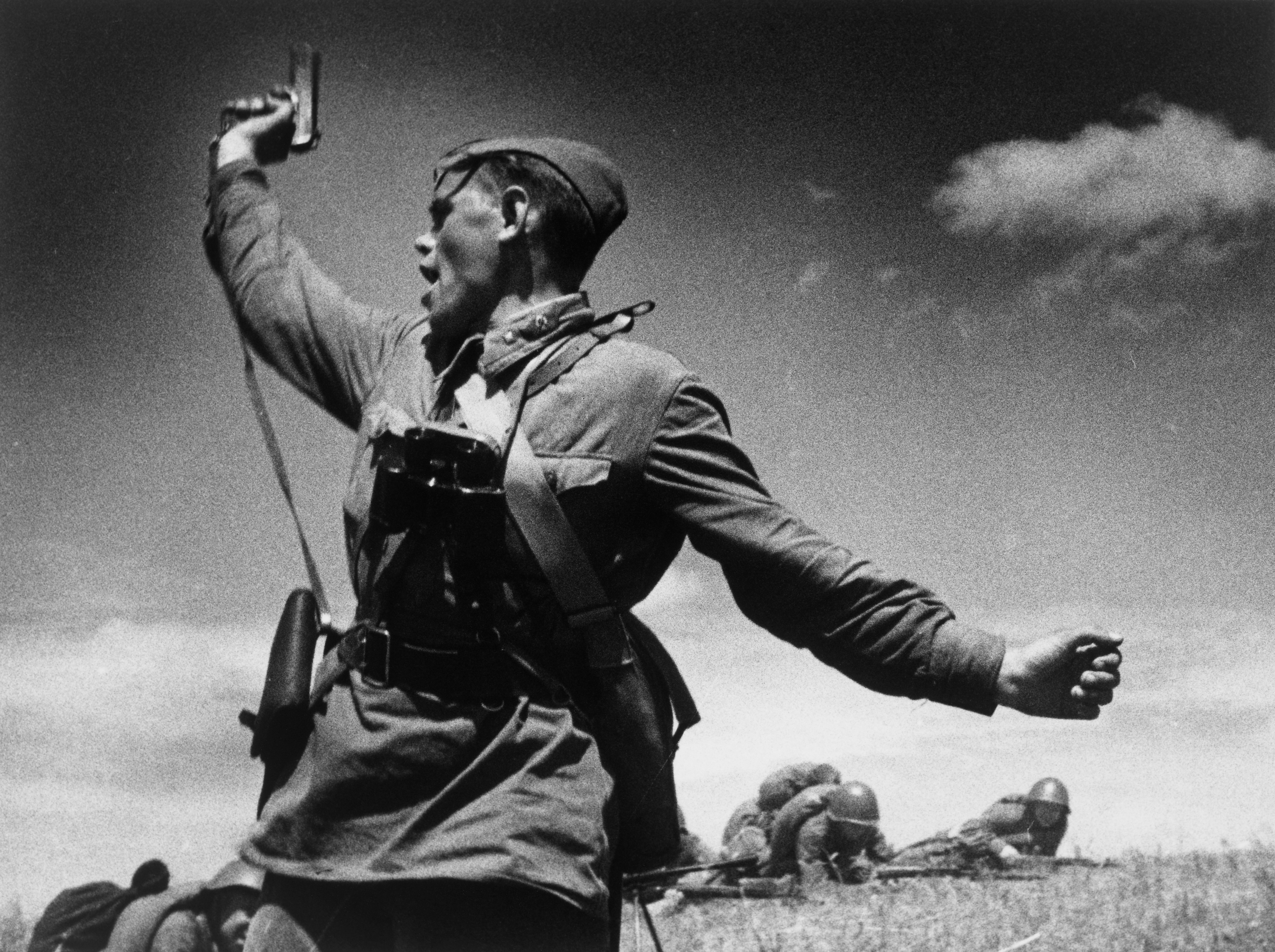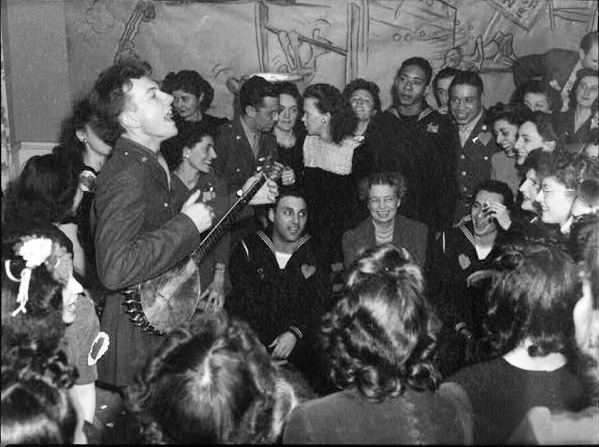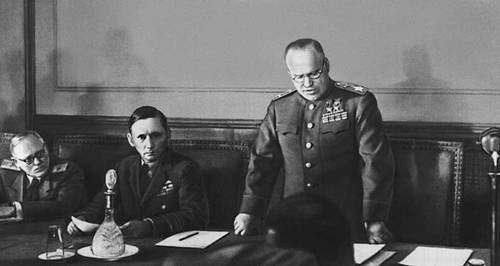|
Combat (military Rank)
(russian: комбат) is the abbreviation from Battalion commander (russian: Командир батальона, Komandir bataljona). It was a military rank in the Red Army from 1918 to 1935. At that time it was roughly equivalent to the rank of captain. Etymologically, the word ''Komandir'' (Commander) is sandwiched with the word ''Batalyona'' (f theBattalion) to make ''Kombat'', similar to compound words in the English language. Combined words like Kombat were commonly used by the Soviet government during the Stalin era such as Komdiv (Division Commander), Komkor (Corps Commander), Kombrig (Brigade Commander), and Komandarm (Army Commander). In popular culture, as for the 50th anniversary of Victory Day, folk rock band Lyube made the World War II song "Kombat" in 1995, which won cultural significance and many awards, leading even Vladimir Putin to commend the band. It is also an informal Russian language abbreviation for the military commander's position for an officer i ... [...More Info...] [...Related Items...] OR: [Wikipedia] [Google] [Baidu] |
Gymnastyorka
Gymnastyorka (usually transliterated in English as Gimnasterka; also spelled ''Gymnastiorka''; rus, гимнастёрка, p=gʲɪmnɐˈsʲtʲɵrkə) was a Russian military smock comprising a pullover-style garment with a standing collar having double button closure. Additionally, one or two upper chest pockets, with or without flaps, may have been worn. It had provision for shoulder boards (epaulettes or shoulder straps) and sometimes reinforced elbows and cuffs. The Tsarist version had the standing collar while the M35 version had a stand-and-fall collar which was replaced with the standing collar in the M43 version. The Soviet Army M35 version usually had hidden buttons. A double breasted version (''kitel'') for officers of all ranks existed during the Tsarist period. Origins The gymnastyorka (till 1917 officially named "gymnastic tunic", гимнастическая рубаха) was originally introduced into the Imperial Russian Army in about 1870 for wear by regiments ... [...More Info...] [...Related Items...] OR: [Wikipedia] [Google] [Baidu] |
Komandarm
is the abbreviation of the russian: Командующий армией, Komanduyushtchi armiy, lit=Commander of the Army / Army commander, and was a military rank used in the Soviet Union. Between 1918 and 1935, it was a rank in the Red Army, roughly equivalent to Flotilla commander in the Red Fleet. In 1935, the rank was split in two, before being abolished and replaced by Army general in 1940. Split In 1935, new ranks were introduced, splitting the rank into two ranks. See also * Ranks and insignia of the Red Army and Navy 1918–1935 * Ranks and insignia of the Red Army and Navy 1935–1940 Rank is the relative position, value, worth, complexity, power, importance, authority, level, etc. of a person or object within a ranking, such as: Level or position in a hierarchical organization * Academic rank * Diplomatic rank * Hierarchy * ... References Military ranks of the Soviet Union {{mil-rank-stub ... [...More Info...] [...Related Items...] OR: [Wikipedia] [Google] [Baidu] |
Artillery Battery
In military organizations, an artillery battery is a unit or multiple systems of artillery, mortar systems, rocket artillery, multiple rocket launchers, surface-to-surface missiles, ballistic missiles, cruise missiles, etc., so grouped to facilitate better battlefield communication and command and control, as well as to provide dispersion for its constituent gunnery crews and their systems. The term is also used in a naval context to describe groups of guns on warships. Land usage Historically the term "battery" referred to a cluster of cannon in action as a group, either in a temporary field position during a battle or at the siege of a fortress or a city. Such batteries could be a mixture of cannon, howitzer, or mortar types. A siege could involve many batteries at different sites around the besieged place. The term also came to be used for a group of cannon in a fixed fortification, for coastal or frontier defence. During the 18th century "battery" began to be used as a ... [...More Info...] [...Related Items...] OR: [Wikipedia] [Google] [Baidu] |
Military Commander
The commanding officer (CO) or sometimes, if the incumbent is a general officer, commanding general (CG), is the officer in command of a military unit. The commanding officer has ultimate authority over the unit, and is usually given wide latitude to run the unit as they see fit, within the bounds of military law. In this respect, commanding officers have significant responsibilities (for example, the use of force, finances, equipment, the Geneva Conventions), duties (to higher authority, mission effectiveness, duty of care to personnel), and powers (for example, discipline and punishment of personnel within certain limits of military law). In some countries, commanding officers may be of any commissioned rank. Usually, there are more officers than command positions available, and time spent in command is generally a key aspect of promotion, so the role of commanding officer is highly valued. The commanding officer is often assisted by an executive officer (XO) or second-in-comma ... [...More Info...] [...Related Items...] OR: [Wikipedia] [Google] [Baidu] |
World War II
World War II or the Second World War, often abbreviated as WWII or WW2, was a world war that lasted from 1939 to 1945. It involved the vast majority of the world's countries—including all of the great powers—forming two opposing military alliances: the Allies and the Axis powers. World War II was a total war that directly involved more than 100 million personnel from more than 30 countries. The major participants in the war threw their entire economic, industrial, and scientific capabilities behind the war effort, blurring the distinction between civilian and military resources. Aircraft played a major role in the conflict, enabling the strategic bombing of population centres and deploying the only two nuclear weapons ever used in war. World War II was by far the deadliest conflict in human history; it resulted in 70 to 85 million fatalities, mostly among civilians. Tens of millions died due to genocides (including the Holocaust), starvation, ma ... [...More Info...] [...Related Items...] OR: [Wikipedia] [Google] [Baidu] |
Lyube
Lyube ( rus, Любэ́, p=lʲʉˈbɛ) is a Russian rock band from Lyubertsy, a city in Moscow Oblast. Lyube's music is a mixture of several genres, with influences from both Russian folk music, rock, Russian chanson, and Soviet military songs. The band was founded in 1989, and since then have released sixteen albums. Lyube's producer and main songwriter is Igor Matviyenko. History Igor Matviyenko was a music producer and composer working at the Soviet music studio SPM Record when he came up with the idea to start Lyube in 1988. His goal was to put together a band with patriotic themed songs and a strong male vocal. After devoting time to finding the right frontman, Matvienko chose Nikolay Rastorguyev, with whom he had worked earlier in the band "Leysia, pesnia" (russian: Лейся, песня, links=no). Rastorguyev came up with the band's name. "Lyube" has two simultaneous derivations. It is a nickname for the Moscow suburb of Lyubertsy, which is where Rastorguyev liv ... [...More Info...] [...Related Items...] OR: [Wikipedia] [Google] [Baidu] |
Folk Rock
Folk rock is a hybrid music genre that combines the elements of folk and rock music, which arose in the United States, Canada, and the United Kingdom in the mid-1960s. In the U.S., folk rock emerged from the folk music revival. Performers such as Bob Dylan and the Byrds—several of whose members had earlier played in folk ensembles—attempted to blend the sounds of rock with their pre-existing folk repertoire, adopting the use of electric instrumentation and drums in a way previously discouraged in the U.S. folk community. The term "folk rock" was initially used in the U.S. music press in June 1965 to describe the Byrds' music. The commercial success of the Byrds' cover version of Dylan's "Mr. Tambourine Man" and their debut album of the same name, along with Dylan's own recordings with rock instrumentation—on the albums ''Bringing It All Back Home'' (1965), ''Highway 61 Revisited'' (1965), and '' Blonde on Blonde'' (1966)—encouraged other folk acts, such as Simon & Ga ... [...More Info...] [...Related Items...] OR: [Wikipedia] [Google] [Baidu] |
Victory Day (9 May)
etc. , nickname = , observedby = Russia and some former states of Soviet Union and Warsaw Pact; Serbia, Israel , duration = 1 day , frequency = Annual , date = 9 May , scheduling = same day each year , celebrations = , observances = , relatedto = Victory in Europe Day Victory Day russian: День Победы, Den' Pobedy uk, День Перемоги, Den' Peremohy be, Дзень Перамогі, Dzień Pieramohi uz, Gʻalaba kuni, Ғалаба куни kk, Jeñis Küni, Жеңіс Күні ka, გამარჯვების დღე, gamarjvebis dghe az, Qələbə Günü, Гәләбә Ҝүнү ro, Ziua Victoriei (Moldovan Cyrillic: Зиуа Викторией) ky, Жеңиш майрамы, Jengish Mayramy tg, Рӯзи Ғалаба, Rūzi Ghalaba hy, Հաղթանակի օրը, Haght'anaki ory tm, Ýeňişlar Harçlaarsiň, Еңишлар Харчлаарсиң is a holiday that commemorates the Soviet victory over Nazi Ge ... [...More Info...] [...Related Items...] OR: [Wikipedia] [Google] [Baidu] |
Kombrig
(russian: комбриг) is an abbreviation of Commanding officer of the brigade (russian: командир бригады, komandir brigady; ), and was a military rank in the Soviet Armed Forces of the USSR from 1935 to 1940. It was also the designation to military personnel appointed to command a brigade sized formation (X). Until 1940 it was the fourth highest military rank of the Red Army. It was equivalent to ''Brigade comissar'' (ru: ) of the political staff in all military branches, ''Kapitan 1st rank'' (ru: ) in the ''Soviet navy'', or to ''Major of state security'' (ru: ). With the reintroduction of regular general ranks, the designation ''Kombrig'' was abolished, and replaced by Major general (OF-6). History This particular rank was introduced by disposal of the Central Executive Committee of the Soviet Union and the Council of People's Commissars, from September 22, 1935.Decree of the Central Executive Committee of the Soviet Union and the Council of People's Commis ... [...More Info...] [...Related Items...] OR: [Wikipedia] [Google] [Baidu] |
Red Army
The Workers' and Peasants' Red Army (Russian: Рабо́че-крестья́нская Кра́сная армия),) often shortened to the Red Army, was the army and air force of the Russian Soviet Federative Socialist Republic and, after 1922, the Union of Soviet Socialist Republics. The army was established in January 1918. The Bolsheviks raised an army to oppose the military confederations (especially the various groups collectively known as the White Army) of their adversaries during the Russian Civil War. Starting in February 1946, the Red Army, along with the Soviet Navy, embodied the main component of the Soviet Armed Forces; taking the official name of "Soviet Army", until its dissolution in 1991. The Red Army provided the largest land force in the Allied victory in the European theatre of World War II, and its invasion of Manchuria assisted the unconditional surrender of Imperial Japan. During operations on the Eastern Front, it accounted for 75–80% of casual ... [...More Info...] [...Related Items...] OR: [Wikipedia] [Google] [Baidu] |
Komkor
(russian: комкор) is the abbreviation for Corps commander (russian: командир корпуса, komandir korpusa; ), and was a military rank in the Soviet Armed Forces of the USSR in the period from 1935 to 1940. It was also the designation for officers appointed to command a corps sized formation. Until 1940 it was the fourth highest military rank of the Red Army. It was equivalent to ''Corps commissar'' (ru: корпусной комиссар) of the political staff in all military branches, '' Flag Officer 1st rank'' (ru: Флагман 1 ранга) in the ''Soviet navy'', or to ''Commissar of state security 3rd rank'' (ru: комиссар государственной безопасности 3-ого ранга). With the reintroduction of regular general ranks in 1940, the designation ''Komkor'' was abolished, and replaced by Colonel general. History This particular rank was introduced by disposal of the Central Executive Committee of the Soviet Union an ... [...More Info...] [...Related Items...] OR: [Wikipedia] [Google] [Baidu] |
Komdiv
(russian: комдив) is the abbreviation to Commanding officer of the Division (russian: командир дивизии, komandir divizii; ), and was a military rank in the Soviet Armed Forces of the USSR in the period from 1935 to 1940. It was also the designation to military personnel appointed to command a division sized formation (XX). Until 1940, it was the fourth highest military rank of the Red Army, and was equivalent to Division commissar () of the political staff in all military branches, Flag Officer 2nd rank (russian: флагман 2-го ранга, Flagman 2-go ranga) in the Soviet navy, or to Senior major of state security (). With the reintroduction of regular general ranks in 1940, the designation was abolished, and replaced by Lieutenant general. History This particular rank was introduced by disposal of the Central Executive Committee of the Soviet Union and the Council of People's Commissars, from September 22, 1935.Decree of the Central Executive Com ... [...More Info...] [...Related Items...] OR: [Wikipedia] [Google] [Baidu] |







